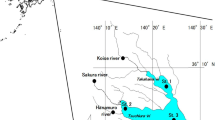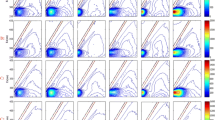Abstract
Previous studies showed that water chemistry and concentrations of dissolved organic matter (DOM) could affect its molecular conformation and binding characteristics with hydrophobic organic contaminants (HOCs). However, the conformational change of DOM resultant from water chemistry and concentrations of DOM was not extensively investigated; therefore, the contradictory reports regarding the binding property with HOCs were available in literature. In this study, the effects of ionic strength, pH and DOM concentrations on the fluorescence properties of two humic acids (HA), namely Fluka HA and Amherst HA, were investigated by three-dimensional excitation-emission matrix fluorescence spectroscopy (3DEEM) and steady-state fluorescence polarization (FP) techniques. The results not only corroborated previous observations obtained by other investigators, but revealed some new information about the fluorescence properties and molecular conformation of the humic acids under different water chemistry and DOM concentration conditions, which could shed light on its binding mechanisms and binding properties with HOCs.
Similar content being viewed by others
References
Au K.K., Penisson A.C., and Yang S. (1999) Natural organic matter at oxide/water interfaces: Complexation and conformation [J]. Geochim. et Cosmochim. Acta. 63, 2903–2917.
Bai Yingchen, Wu Fengchang, Wan Guojiang, Liu Chongqiang, Fu Pingqing, and Li Wen (2008) Ultraviolet absorbance titration for the determination of conditional stability constants of Hg(II) and dissolved organic matter [J]. Chinese Journal of Geochemistry. 27, 47–52.
Baker A. (2001) Fluoreseenee excitation-emission matrix characterization of sortie sewage-impacted rivers [J]. Environmental Science and Technology. 35, 948–953.
Banaitis M.R., Waldrip-Dail H., and Diehl M.S. (2006) Investigating sorption-driven dissolved organic matter fractionation by multidimensional fluorescence spectroscopy and PARAFAC [J]. Colloid Interface Science. 304, 271–276.
Bengraïne K. and Marhaba T.F. (2003) Comparison of spectral fluorescent signature-based models to characterize DOM in treated water samples [J]. Journal of Hazardous Materials. B100, 117–130.
Chen Wen, Westerhoff P., Leenheer J.A., and Booksh K. (2003) Fluorescence excitation-emission matrix regional integration to quantify spectra for dissolved organic matter [J]. Environmental Science and Technology. 37, 5701–5710.
Coble P.G. (1996) Characterization of marine and terrestrial NOM in seawater using excitation-emission matrix spectroscopy [J]. Marine Chemistry. 51, 325–346.
Engebretson R.R. and Von Wandruszka R. (1994) Microorganization in dissolved humic acids [J]. Environmental Science and Technology. 28, 1934–1941.
Esteves da Silva J.C., Tavares M.J., and Tauler R. (2006) Multivariate curve resolution of multidimensional excitation-emission quenching matrices of a Laurentian soil fulvic acid [J]. Chemosphere. 64, 1939–1948.
Frimmel F.L. (1998) Characterization of natural organic matter as constituents in aquatic systems [J]. Journal of Contaminant Hydrology. 35, 201–216.
Fu Pingqing, Wu Fengchang, and Liu Chongqiang (2004) Fluorescence excitation-emission matrix characterization of a commercial humic acid [J]. Chinese Journal of Geochemistry. 23, 309–318.
Ghosh K. and Schnitzer M. (1980) Fluorescence excitation spectra of humic substances [J]. Canadian Journal of Soil Science. 60, 373–379.
Jones K.D. and Tiller C.L. (1999) Effect of solution chemistry on the extent of binding of phenanthrene by a soil humic acid: A comparison of dissolved and clay bound humic [J]. Environmental Science and Technology. 33, 580–587.
Lakowicz J.R. (1983) Principles of Fluorescence Spectroscopy [M]. pp. 1–496. Plenum, New York.
Laor Y., Storm P.F., and Farmer W.J. (1999) Bioavilability of phenanthrene sorbed to mineral-associated humic acid [J]. Water Research. 33, 1719–1729.
Lapen A.J. and Seitz W.R. (1982) Fluorescence polarization studies of the conformation of soil fulvic acid [J]. Analytical Chimistry Acta. 134, 31–38.
Leenheer J.A. and Croué J.P. (2003) Characterizing aquatic dissolved organic matter [J]. Environmental Science and Technology. 37, 19A–26A.
Lochmüller C.H. and Saavedra S.S. (1986) Conformational changes in a soil fulvic acid measured by time-dependent fluorescence depolarization [J]. Analytical Chemistry. 58, 1978–1981.
Matthews B.J.H., Jones A.C., Theodorou N.K., and Tudhope A.W. (1996) Excitation-emission-matrix fluorescence spectroscopy applied to humic acid bands in coral reefs [J]. Marine Chemistry. 55, 317–332.
Maurice P.A. and Namjesnik-Dejanovic K. (1999) Aggregate structures of sorbed humic substances observed in aqueous solution [J]. Environmental Science and Technology. 33, 1538–1541.
McCarthy J.F. and Jimenez B.D. (1985) Interactions between polycyclic aromatic hydrocarbons and dissolved humic material: Binding and dissociation [J]. Environmental Science and Technology. 19, 1072–1076.
Miano T.M. and Senesi N. (1992) Synchronous excitation fluorescence spectroscopy applied to soil humic substances chemistry [J]. Science of the Total Environment. 117–8, 41–51.
Mobed J.J., Hemmingsen S.L., and Autry J.H. (1996) Fluorescence characterization of IHSS humic substances: Total luminescence spectra with absorbance correction [J]. Environmental Science and Technology. 30, 3061–3065.
Mopper K. and Schultz C.A. (1993) Fluorescence as a possible tool for studying the nature and water column distribution of DOC components [J]. Marine Chemistry. 41, 229–238.
Murphy E.M., Zachara J.M., Smith S.C., Phillips J.L., and Wietsma T.W. (1994) Interaction of hydrophobic organic compounds with mineral-bound humic substances [J]. Environmental Science and Technology. 28, 1283–1289.
Myneni S.C.B., Brown J.T., Martinez G.A., and Meyer-Ilse W. (1999) Imaging of humic substance macromolecular structures in water and soil [J]. Science. 286, 1335–1337.
Pan Bo, Ghosh S., and Xing B.S. (2008) Dissolved organic matter comformation and its interaction with Pyrene as affected by water chemistry and concentration [J]. Environmental Science and Technology. 42, 1594–1599.
Pan Bo, Xing Baoshan, Liu Wenxin, Xing Guanhua, and Tao Shu (2007) Investigating interactions of phenanthrene with dissolved organic matter: Limitation of Stern-Volmer polt [J]. Chemosphere. 69, 1555–1562.
Perminova I.V., Grechishcheva N.Y., Kovalevskii D.V., Kudryavtsev A.V., Petrosyan V.S., and Matorin D.N. (2001) Quantification and prediction of the detoxifying properties of humic substances related to their chemical binding to polycyclic aromatic hydrocarbons [J]. Environmental Science and Technology. 35, 3841–3848.
Pullin M.J. and Cabaniss S.E. (1995) Rank analysis of the pH dependent synchronous fluorescence spectra of six standard humic substances [J]. Environmental Science and Technology. 29, 1460–1467.
Ryan D.K. and Weber J.H. (1982) Fluorescence quenching titration for determination of complexing capacities and stability constants of fulvic acid [J]. Analytical Chemistry. 54, 986–990.
Schlautman M.A. and Morgan J.J. (1993). Effects of aqueous chemistry on the binding of polycyclic aromatic hydrocarbons by dissolved humic materials [J]. Environmental Science and Technology. 27, 961–969.
Senesi N. (1990) Molecular and quantitative aspects of the chemistry of fulvic acid and its interactions with metal ions and organic chemicals. Part II: The fluorescence spectroscopy approach [J]. Analytical Chimistry Acta. 232, 77–106.
Senesi N., Miano T.M., Provenzano M.R., and Brunetti G. (1989) Spectroscopic and compositional comparative characterization of I.H.S.S. reference and standard fulvic and humic acids of various origin [J]. Science of the Total Environment. 81–2, 143–156.
Stevenson F.J., Fitch A., and Brar M.S. (1993) Stability constants of Cu(II) humate complexs: comparison of select models [J]. Soil Science. 155, 77–91.
Traina S.J., Novak J., and Smeck N.E. (1990) An ultraviolet absorbance method of estimating the percent aromatic carbon content of humic acids [J]. Journal of Environmental Quality. 19, 151–153.
Wagoner D.B. and Christman R.F. (1997) Molar mass and size of Suwannee River natural organic matter using multi-angle laser light scattering [J]. Environmental Science and Technology. 31, 937–941.
Wu Fengchang and Tanoue E. (2001) Molecular mass distribution and fluorescence characteristics of dissolved organic ligands for copper (II) in Lake Biwa, Japan [J]. Organic Geochemistry. 32, 11–20.
Author information
Authors and Affiliations
Corresponding author
Rights and permissions
About this article
Cite this article
Mei, Y., Wang, L. & Wu, F. Effects of water chemistry and concentrations of dissolved organic matter on its fluorescence characteristics and molecular conformation. Chin. J. Geochem. 28, 413–420 (2009). https://doi.org/10.1007/s11631-009-0413-2
Received:
Accepted:
Published:
Issue Date:
DOI: https://doi.org/10.1007/s11631-009-0413-2




